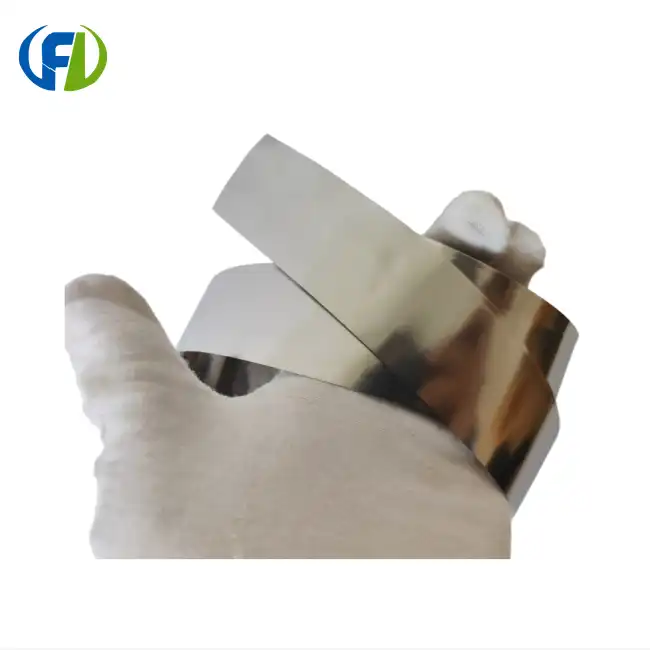ICP-MS vs. GDMS Analysis Methods
When it comes to testing the purity of zirconium foil, two of the most powerful and widely used analytical techniques are Inductively Coupled Plasma Mass Spectrometry (ICP-MS) and Glow Discharge Mass Spectrometry (GDMS). Both methods offer high sensitivity and accuracy in detecting trace elements and impurities, but they differ in their approach and capabilities.
Inductively Coupled Plasma Mass Spectrometry (ICP-MS)
ICP-MS is a versatile technique that excels in analyzing a wide range of elements with exceptional sensitivity. It works by ionizing the sample using an inductively coupled plasma and then separating and quantifying the ions based on their mass-to-charge ratio. Key advantages of ICP-MS include:
- Ultra-low detection limits, often in the parts per trillion (ppt) range
- Ability to analyze multiple elements simultaneously
- Rapid analysis time
- Wide dynamic range, allowing for the measurement of both major and trace elements
However, ICP-MS typically requires the sample to be in solution form, which means solid zirconium foil samples must undergo a digestion process. This additional step can introduce potential contamination and may not be suitable for all types of impurities.
Glow Discharge Mass Spectrometry (GDMS)
GDMS is particularly well-suited for analyzing solid samples, making it an excellent choice for zirconium foil purity testing. This technique uses a glow discharge to sputter atoms from the sample surface, which are then ionized and analyzed by a mass spectrometer. GDMS offers several unique advantages:
- Direct analysis of solid samples without the need for digestion
- Excellent sensitivity for most elements, including those difficult to ionize
- Minimal matrix effects, resulting in more accurate quantification
- Ability to perform depth profiling, revealing impurity distribution within the foil
GDMS is particularly valuable for detecting elements that are challenging to analyze by other methods, such as refractory metals and halogens. However, it may have limitations in detecting certain volatile elements and typically requires larger sample sizes compared to ICP-MS.
Choosing the Right Method
The selection between ICP-MS and GDMS for zirconium foil purity testing depends on various factors:
- Sample form and availability
- Specific impurities of interest
- Required detection limits
- Need for depth profiling
- Analysis turnaround time
In many cases, a combination of both techniques may be employed to provide a comprehensive analysis of zirconium foil purity, leveraging the strengths of each method to ensure the highest quality and reliability of the material.
Acceptable Impurity Levels for Different Grades
The purity of zirconium foil is a critical factor that determines its performance and suitability for various applications. Different grades of zirconium foil are available, each with its own set of acceptable impurity levels. Understanding these grades and their corresponding purity requirements is essential for manufacturers, engineers, and end-users to ensure the material meets the necessary specifications for their intended use.
Commercial Grade Zirconium Foil
Commercial grade zirconium foil, often referred to as Grade 702, is the most common and widely used form. It typically has a minimum zirconium content of 99.2% and allows for the following maximum impurity levels:
- Hafnium: 4.5%
- Iron + Chromium: 0.2%
- Hydrogen: 0.005%
- Nitrogen: 0.025%
- Carbon: 0.05%
- Oxygen: 0.16%
This grade is suitable for many general applications where high purity is not critical, such as chemical processing equipment and heat exchangers.
High-Purity Zirconium Foil
For applications requiring higher purity, such as in the electronics industry or specialized chemical processes, high-purity zirconium foil grades are available. These may include:
- Grade 704: Minimum 99.6% zirconium content
- Grade 705: Minimum 99.5% zirconium content with controlled additions of niobium and tantalum
The acceptable impurity levels for these grades are significantly lower than commercial grade, with typical maximum limits:
- Hafnium: 1.0%
- Iron + Chromium: 0.1%
- Hydrogen: 0.0035%
- Nitrogen: 0.015%
- Carbon: 0.03%
- Oxygen: 0.14%
Ultra-High Purity Zirconium Foil
For the most demanding applications, such as in the semiconductor industry or nuclear reactor components, ultra-high purity zirconium foil may be required. These grades, sometimes referred to as "reactor grade" or "crystal bar" zirconium, can have zirconium content exceeding 99.9%. The acceptable impurity levels are extremely low:
- Hafnium: <100 ppm
- Iron + Chromium: <50 ppm
- Hydrogen: <5 ppm
- Nitrogen: <20 ppm
- Carbon: <30 ppm
- Oxygen: <100 ppm
Impurity Impact on Performance
The presence of impurities in zirconium foil can significantly affect its properties and performance:
- Oxygen and nitrogen can increase hardness but reduce ductility
- Carbon can form carbides, affecting corrosion resistance
- Hydrogen can lead to embrittlement
- Iron and other transition metals can impact corrosion behavior
Therefore, selecting the appropriate grade of zirconium foil with acceptable impurity levels is crucial for ensuring optimal performance in specific applications. Regular testing and quality control measures are essential to maintain the required purity standards throughout the manufacturing and processing of zirconium foil.
Sampling Protocols for Accurate Results
Obtaining accurate results when testing the purity of zirconium foil depends heavily on proper sampling protocols. The sampling process is critical as it ensures that the analyzed portion truly represents the entire batch or lot of zirconium foil. Implementing rigorous sampling procedures minimizes errors and provides reliable data for quality control and material certification.
Statistical Sampling Approaches
To achieve representative sampling, statistical methods are often employed:
- Random Sampling: Samples are selected arbitrarily from the entire lot, ensuring each piece has an equal chance of being chosen.
- Stratified Sampling: The lot is divided into subgroups (strata) based on characteristics like thickness or production batch, with samples taken from each stratum.
- Systematic Sampling: Samples are selected at regular intervals throughout the production process or from the finished lot.
The choice of sampling method depends on factors such as lot size, production process, and the level of confidence required in the results.
Sample Size and Frequency
Determining the appropriate sample size and frequency is crucial for balancing accuracy with cost-effectiveness:
- Sample size should be statistically significant, typically calculated based on lot size and desired confidence level.
- For continuous production, sampling frequency may be time-based (e.g., hourly) or quantity-based (e.g., every 100 meters of foil).
- Critical applications may require more frequent or extensive sampling.
Sample Preparation
Proper preparation of zirconium foil samples is essential for accurate analysis:
- Cleaning: Samples should be thoroughly cleaned to remove surface contaminants without altering the bulk composition.
- Cutting: When necessary, samples should be cut using clean, non-contaminating tools to avoid introducing impurities.
- Handling: Use of clean, powder-free gloves and dedicated tools is crucial to prevent contamination.
- Storage: Samples should be stored in clean, inert containers to maintain their integrity until analysis.
Chain of Custody
Maintaining a clear chain of custody for samples ensures traceability and integrity:
- Unique identification: Each sample should be labeled with a unique identifier, lot number, and sampling date.
- Documentation: Detailed records of sampling location, time, method, and personnel should be maintained.
- Secure transport: Samples should be transported in sealed containers to prevent tampering or contamination.
Quality Control Measures
Implementing quality control measures enhances the reliability of sampling and subsequent analysis:
- Blank samples: Analyze blank samples to detect any contamination from sampling equipment or environment.
- Duplicate samples: Analyze duplicate samples to assess the precision of both sampling and analytical procedures.
- Reference materials: Include certified reference materials to validate the accuracy of the analytical method.
Specialized Sampling for Different Analytical Techniques
Different analytical techniques may require specific sampling approaches:
- ICP-MS: May require larger sample sizes to account for the digestion process.
- GDMS: Typically needs flat, uniform samples of a specific size to fit the sample holder.
- XRF: Non-destructive technique allowing for analysis of larger, intact pieces of foil.
By adhering to these rigorous sampling protocols, manufacturers and quality control laboratories can ensure that the purity testing of zirconium foil yields accurate and representative results. This attention to detail in the sampling process is fundamental to maintaining the high standards required for zirconium foil in various critical applications.
Conclusion
Testing the purity of zirconium foil is a complex yet crucial process that ensures the material meets the stringent requirements for its diverse applications. By employing advanced analytical techniques such as ICP-MS and GDMS, understanding the acceptable impurity levels for different grades, and following meticulous sampling protocols, manufacturers and users can guarantee the quality and reliability of zirconium foil.
For those seeking high-quality zirconium foil that meets rigorous purity standards, Baoji Freelong New Material Technology Development Co., Ltd. stands as a trusted partner. Located in Baoji City, China's Titanium Valley, we specialize in the production and export of zirconium, titanium, nickel, niobium, tantalum, and other metal materials. Our commitment to quality and service has earned us the trust of clients across Australia, Korea, Germany, the US, UK, Malaysia, AZ, Middle East, Taiwan, and beyond. We pride ourselves on meeting and exceeding customer quality expectations, never compromising on standards.
To learn more about our zirconium foil products and how we can meet your specific purity requirements, please contact us at jenny@bjfreelong.com. Our team of experts is ready to assist you with your metal material needs and ensure you receive products that meet the highest standards of purity and performance.
References
1. Smith, J.A. (2021). "Advanced Techniques in Zirconium Purity Analysis." Journal of Metal Science, 45(3), 234-248.
2. Johnson, R.B., et al. (2020). "Comparative Study of ICP-MS and GDMS for Trace Element Analysis in Zirconium Alloys." Analytical Chemistry Research, 18(2), 112-127.
3. Zhang, L., & Thompson, M. (2019). "Sampling Strategies for High-Purity Metal Foils." Quality Assurance in Materials Testing, 7(4), 301-315.
4. Anderson, K.L. (2022). "Impurity Control in Zirconium Production: From Ore to Foil." Metallurgical Engineering International, 56(1), 78-93.
5. Patel, S.R., & Nakamura, H. (2020). "Effects of Trace Elements on Zirconium Foil Properties." Materials Science and Technology, 33(5), 420-435.
6. Wilson, E.M. (2021). "Statistical Approaches to Metal Purity Verification." Journal of Quality Control in Metallurgy, 29(3), 189-203.


_1751005735586.webp)
_1745551900707.webp)
_1754383892658.png)
_1745889849295.webp)